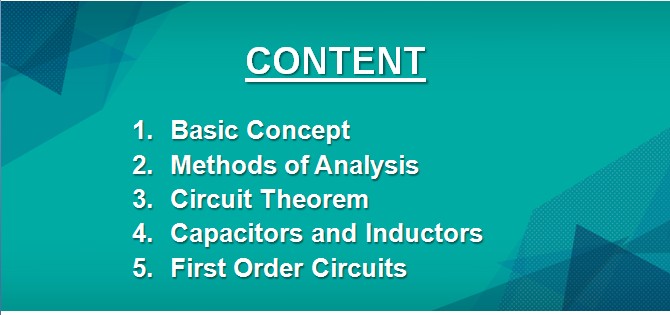Circuit Analysis 1
Topic outline
-


Synopsis
This course introduces the basic concepts and engineering methods of DC circuit analysis. The contents include Ohm's Law, Kirchhoff's Law, series and parallel circuits, Mesh and Nodal analysis, Superposition, Source Transformation, Thevenin’s and Norton’s theorems, Capacitor, Inductor and responses of First Order circuits.
Course Outcomes
At the end of this course student should be able to:
(i) Attribute the basic concepts of electrical quantities by using basic circuit laws (Ohm's law and Kirchhoff's law) and simplification of resistive circuits(ii) Analyze DC circuit problems using circuit theorem, nodal analysis and mesh analysis(iii) Attribute the basic concepts of capacitance and inductance and analyze the characteristic of natural and step response in first order circ uits(iv) Construct DC electric circuits to apply the concept of electrical quantities and verify circuit theorems(v) Demonstrate the role of individual in the team to achieve task completionReferences
1. C. Alexander and M. Sadiku, “Fundamentals of Electric Circuits”, 4th ed., McGraw-Hill, 2008.
2. J. Nilsson and S. Riedel, “Electric Circuits”, 8th ed., Prentice Hall, 2008.
3. R. Dorf and J. Svoboda, "Introduction to Electric Circuits", 8th ed., John Wiley & Sons, 2010.
-
Forum
-
-
Chapter 1A: Basic Concept
1.1 Introduction of circuit analysis
1.2 Electrical quantities: Systems of units, charge, current, voltage, power and energy
1.3 Circuit elements: Passive and active elements, independent and dependent sources
-
Chapter 1B: Basic Concept
2.1 Ohm’s Law and Kirchhoff's Law
2.2 Nodes, branches and loops
2.3 Resistive circuit: Series, parallel circuits and combination circuits
-
File
-
Chapter 1C: Basic Concept
3.1 Principles of voltage division and current division
3.2 Delta-wye transformation
-
Chapter 2A: Methods of Analysis (DC Circuits)
4.1 Nodal Analysis
4.2 Nodal analysis with voltage sources: Supernode
-
Chapter 2B: Methods of Analysis (DC Circuits)
5.1 Mesh Analysis
5.2 Mesh Analysis with current sources: Supermesh
5.3 Nodal versus Mesh Analysis
-
File
-
Chapter 3A: Circuit Theorem (DC Circuits)
6.1 Superposition Principles
6.2 Source Transformation
-
Chapter 3B: Circuit Theorem (DC Circuits)
7.1 Thevenin's and Norton's Theorem (Independent and Dependent source)
7.2 Maximum Power Transfer
-
File
-
Chapter 4: Capacitors and Inductors
8.1 Series and Parallel Capacitors
8.2 Series and Parallel Inductors
-
File
-
Chapter 5A: First Order Circuits
9.1 Introduction to energy storage elements
9.2 The source-free RC circuit
9.3 The source-free RL circuit
9.4 Unit step function
-
File
-
Chapter 5B: First Order Circuits
10.1 Step response of an RC Circuit
10.2 Step response of an RL Circuit
-
Labsheet
1. Laboratory 1: Ohm's Law and Kirrchoff's Law (Laboratory report)
2. Laboratory 2: Nodal and Mesh Analysis (Technical Skill)
